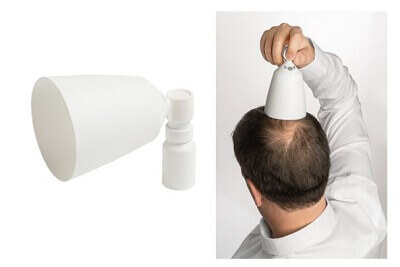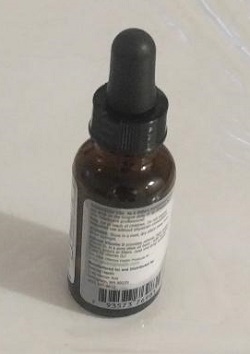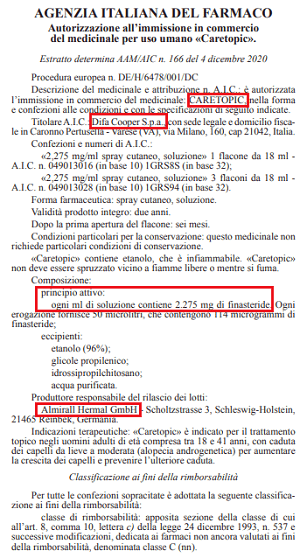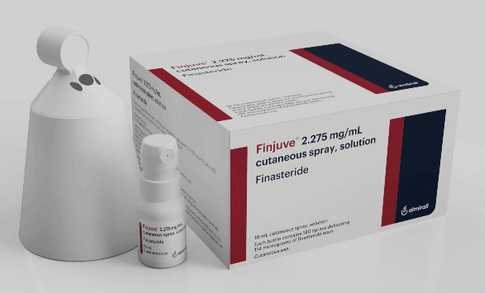I originally wrote this post in June 2014. I update it every two years and have now added an curreent online buying options list at the bottom of this page. Make sure to also read my many other posts related to topical finasteride.
Less Systemic Absorption of Topical Finasteride
A new 2021 study (458 patients) on topical finasteride spray solution (from Almirall) concluded that it causes improved hair growth to the same degree as oral finasteride. Moreover, the topical version led to markedly lower systemic exposure. The below topical finasteride spray application image is from the study. Dr. Kelly Scarberry makes the following conclusion:
“Topical finasteride appears to be more effective at treating androgenic alopecia than placebo and may have similar efficacy as oral finasteride, with fewer systemic side effects.”

Maximum plasma finasteride concentrations were >100 times lower with topical finasteride spray solution. Mean serum DHT concentration was lower (34.5% vs 55.6%), with topical versus oral finasteride. There is a smaller risk of systemic adverse sexual side effects with topical finasteride.
Almirall ALM12845: 2024 Update
Spain-based Almirall finally released its much anticipated ALM12845 topical finasteride in 2021. However, the company announced that it will not directly sell or market this product. Instead, it will launch the product via licensing partnerships in various countries.
- Difa Cooper of Italy will produce and market it in parts of Western Europe under the brand name “Caretopic“.
- Hikma Pharmaceutical will sell it as “Finjuve” in the Middle East and North Africa (announced in November 2021).
- Boryung Pharmaceutical will sell it as “Finjuve” in South Korea (announced in January 2022).
- Cutia Therapeutics has licensed it for the Hong Kong market via the name CU-40102. At the end of 2024, they will also offer it in mainland China.
Note that this product was previously known as Polichem’s P-3074. Almirall purchased Polichem in 2015.
The company filed for a Marketing Authorization Application (MAA) with the European Medicines Agency (EMA) in September 2019. The ALM12845 product is described as a cutaneous spray solution for the topical treatment of men with androgenetic alopecia. I am not sure if they will be able to get FDA approval to market in the US as yet.
Polichem’s P-3074
The original research and trial work on Almirall’s topical finasteride was undertaken by Polichem. The company released its P-3074 final clinical trial results in 2019. P-3074 is a new topical finasteride solution with hydroxypropyl-chitosan as the film-forming agent.
The interesting thing about this study is that four different doses (ranging from 0.25 mg to 1 mg) of topical finasteride were tested. The study entailed 32 human participants, with 8 of those 32 getting a placebo dose. One negative thing about the study is that only a 7-day dose of the topical P-3074 solution was administered. There will therefore be no long-term measurement of the effectiveness of P-3074. It will be interesting to see the results of this study regarding yet another new hair loss product.
Note that a similar trial (although at just one dosage level of 0.25 mg per day) for P-3074 was conducted in the past. Its findings were presented at the 7th World Congress on Hair Research (WCHR 2013). The conclusion of this trial was quite significant:
“These findings show that DHT concentration in the scalp, after 7-day treatment course of P-3074 once daily, was more reduced (about 40%) than after 1 mg oral finasteride administration for the same treatment period.”
Topical Finasteride for Hair Loss
Recent reports suggest that topical finasteride results in similar increases in hair count compared to oral finasteride. Topical finasteride is typically compounded in gel or solution form. The oral version can come in pill, capsule or tablet form. It is hoped and likely that the topical version has fewer side effects than the oral version.
2018 update: A systemic review of topical finasteride shows consistent reduction in hair loss. Both scalp and plasma DHT levels decreased significantly. Also see Dr. Nicole Rogers’ comments on these findings.

The manufacturer of Propecia (Merck) applied for a patent for topical finasteride in 2002. However, the company has to date never tried to develop an actual product.
This is all the more surprising when considering that Propecia has been getting significant negative publicity of late. Many users suffering from long-term sexual side effects have filed a class-action lawsuit against Merck.
It should also be noted that the original Merck patent for Propecia has a number of sentences mentioning topical formulations as likely being effective.
Topical Finasteride Side Effects
The main reason that people are so excited about topical finasteride is because of potentially fewer side effects in comparison to oral finasteride. Serum dihydrotestosterone (DHT) inhibition in the blood is significantly less with topical finasteride versus oral finasteride. At the same time, scalp DHT inhibition will remain similar with both delivery mechanisms.
However, it should be noted that different formulations will result in different levels of DHT inhibition. It is therefore imperative to be very careful if you are purchasing this product from any compounding pharmacy. Some of the below collected sources indicate that sexual side effects will be less likely with topical finasteride. At the same time, hair growth benefits will be similar for oral versus topical.
References and Studies
There have been other studies done in the past that concluded favorable results from topical finasteride. For example, a 2009 study from Iran concluded: “the therapeutic effects of both finasteride gel and finasteride tablets were relatively similar to each other.” Nothing is mentioned regarding side effects in the abstract of that study.
A 2012 study from Thailand concluded that a 3% minoxidil plus 0.1% finasteride lotion (“MFX”) was superior to just 3% minoxidil (“MNX’). There is also an increasing amount of new research on better ways to deliver topical finasteride, especially via nanocarriers.
Update: April 2020 — A new study found topical finasteride to be more effective than topical 17α-estradiol in women suffering from female pattern hair loss (FPHL). Make sure to also read my post on estrogen and hair growth.
Dutasteride
What I am really hoping for are future studies on topical dutasteride. The main reason for this, besides dutasteride’s superior results to finasteride, is that type I 5α-reductase isoenzymes are more prevalent on the scalp. Type II 5α-reductase isoenzymes are more prevalent in the prostate.
Finasteride primarily inhibits type II 5α-reductase, while dutasteride also inhibits type I 5α-reductase. I would therefore not be surprised if topical dutasteride’s superiority over topical finasteride is even greater than the superiority of dutasteride pills over finasteride pills. Hopefully, there will also be fewer side effects even after accounting for some systemic absorption via the scalp.
A few hair transplant surgeons have developed their own topical finasteride solution, usually in partnership with local pharmacies. If you happen to have heard more on this, please post in the comments section below this post.
Some hair loss forum participants seem to have tried to develop their own topical finasteride or even topical dutasteride. Something I would not recommend. The science of topical medication delivery is a bit too complex for the vast majority of us to be experimenting with on ourselves.
Buying Options for Topical Finasteride in 2022
A number of doctors, clinics and local pharmacies can already prescribe and compound topical finasteride for you. However, such localized products will never be substantiated by expensive clinical studies, as is the case with Almirall’s ALM12845 product. Moreover, a large pharmaceutical company such as Polichem can devote years of research in perfecting its drug delivery system.
In any event, the below online companies and brands have become popular for their topical finasteride products. Especially in the US. Costs can vary significantly, and most offer monthly subscription plans. Note that you can not purchase this prescription product from Amazon. Make sure to read online reviews and ratings of these products on Reddit and on hair loss forums before considering a purchase. Dosages currently range from 0.25%-0.30%.
- Hair Science Formula 82F — A liquid solution that includes Finasteride 0.25% and Minoxidil 5%.
- HairStim — Finasteride plus various personalized compounds, including high-dose Minoxidil 6-7%, Spironolactone, Resveratrol and Latanoprost.
- Triple Hair Therapy-07 — Finasteride, Minoxidil and Latanoprost. Currently sold via prescription from a third party compounding pharmacy. Triple Hair is also preparing for Phase 3 clinical trials.
- Happy Head — a liquid solution that includes Finasteride 0.25%, Minoxidil 8% and Retinoic Acid 0.01%.
- Hims — A spray that includes Finasteride 0.3% and Minoxidil 6%).
- Keeps — A gel that includes Finasteride 0.25% and Minoxidil 5%).
- XYON Health — Nanoparticle gel technology. Note that this is Dr. Hasson’s new company. Make sure to read their article on the SiloxysSystem™ gel technology.
- Roman — Their 3-in-1 Hair Solution Rx spray is compounded with Finasteride, Minoxidil and Tretinoin,
- Strut — Gel and solution options, customized to include up to 0.25% Finasteride, 7.5% Minoxidil, 0.0125% Tretinoin & Biotin).
- Almirall — Caretopic and Finjuve brands depending on country. This is the only topical Finasteride product that has gone through rigorous clinical trials over many years.
The below is a great detailed recent video on topical finasteride dosage versus side effect considerations.

